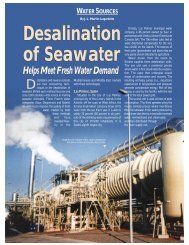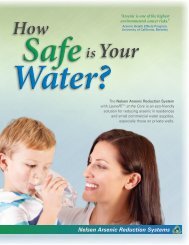Looking Toward the Future - Water Quality Products
Looking Toward the Future - Water Quality Products
Looking Toward the Future - Water Quality Products
You also want an ePaper? Increase the reach of your titles
YUMPU automatically turns print PDFs into web optimized ePapers that Google loves.
editor’s emphasis WQA Aquatech USA 2012 Wrap UpFinal Barrier<strong>Looking</strong> <strong>Toward</strong> <strong>the</strong> <strong>Future</strong>By Regu P. RegunathanFinal barrier technologyis poised to providetreatment solutionsaround <strong>the</strong> worldWhat exactly is final barrier?How does it work? Wheredoes it fit into my business?These are questions asked bymany dealers in <strong>the</strong> water treatmentindustry. The WQA Aquatech USA2012 tradeshow, held March 6 to 9,focused on <strong>the</strong>se questions with amixture of presentations and a focusgroup discussion.Protection From DiseaseDr. Charles P. Gerba is a wellknownexpert in <strong>the</strong> field of microbiologyof water. He is a professor in<strong>the</strong> department of soil, water and environmentalscience at <strong>the</strong> University ofArizona. He has authored more than11 books, written chapters in morethan 80 o<strong>the</strong>r books and publishedmore than 340 peer-reviewed journalarticles. He gave a presentation atWQA Aquatech USA 2012 titled,“Final Barrier – Global Perspective.”According to Gerba, based onstudies he has conducted or reviewed,from a microbiological point of view,<strong>the</strong>re is a need for final barrier technologyin countries in both <strong>the</strong> developingand developed worlds. He pointsout that in many countries or regionsof <strong>the</strong> developing world, poor sourcewater, inadequate or non-existent treatmentand contaminated storage anddistribution system intrusions lead tohigh incidences of disease.Worldwide, <strong>the</strong>re are 2.6 billionpeople without access to sanitationand 900 million people without accessto safe water. According to <strong>the</strong> WorldHealth Organization (WHO), during<strong>the</strong> last decade <strong>the</strong>re were 132,000cases of cholera, 16 million cases oftyphoid and 4.6 billion cases of diarrheaper year worldwide. This lead to3 million deaths annually, mostly ofyoung children. According to Gerba,<strong>the</strong>se facts emphasize <strong>the</strong> need for finalbarrier processes and devices for everyfamily in <strong>the</strong> developing world.When it comes to <strong>the</strong> developedworld, <strong>the</strong>re are a variety of factors thatpoint to <strong>the</strong> need for final barrier technologyas well. According to Gerba’sresearch, waterborne pathogens cannotbe removed 100% of <strong>the</strong> time byconventional water treatment processesin a central water treatment plant, andwater-based pathogens often grow indistribution systems. Contaminationof distribution systems through intrusionor main breakage also is beingreported, and widespread occurrenceof enteric viruses is being recognized ingroundwater sources.In regard to waterborne diseases,it was discovered recently that somechronic diseases are caused by waterborneand water-based pathogens.Sensitive populations, such as infants,children, <strong>the</strong> elderly, mo<strong>the</strong>rs, womenof maternal age, immunocompromisedindividuals and <strong>the</strong> chronicallyill require water with more enhancedquality than <strong>the</strong> rest of <strong>the</strong> population.Such populations are increasing,comprising 25% to 30% of <strong>the</strong> currentpopulation. The estimated number ofendemic cases of waterborne illnessin <strong>the</strong> U.S. is about 25 million peryear. According to Gerba, all of <strong>the</strong>sefactors point to <strong>the</strong> need for finalbarrier devices in homes in developedcountries as well.Two microbiological guide standardshave been developed to evaluatemicrobial final barrier devices, one by<strong>the</strong> U.S. Environmental ProtectionAgency (EPA) 25 years ago, andano<strong>the</strong>r by WHO in 2011. While<strong>the</strong>re are some differences in <strong>the</strong> twoguides, both approach <strong>the</strong> need fortesting and evaluating <strong>the</strong>se devices ina similar manner.Small Systems ApplicationsThomas Sorg, P.E., is ano<strong>the</strong>r wellknownexpert in his field. He hasworked with federal environmentalprograms for 47 years; <strong>the</strong> last 37have been with EPA’s drinking waterresearch and development program.Sorg has been chief of <strong>the</strong> inorganicsand particulate control branch of <strong>the</strong>drinking water research division for 25years. He gave a presentation at WQAAquatech USA 2012 titled, “FinalBarrier – Small System Compliance.”Sorg focuses on <strong>the</strong> use of pointof-use(POU) and point-of-entry(POE) devices as final barriers inhomes in small communities tocomply with EPA’s chemical contaminantregulations. According to Sorg,<strong>the</strong>re are many issues associated with<strong>the</strong>se applications.EPA breaks small systems intothree categories based on population:25 to 500; 501 to 3,300; and 3,301to 10,000. The agency lists POU as asmall system compliance technologyspecifically in <strong>the</strong> radionuclide andarsenic rules because it is more affordablefor small systems and can help<strong>the</strong>m comply with <strong>the</strong>se rules.Approximately 40% of statesallow POU for compliance purposes.Ano<strong>the</strong>r 20% allow POU for compliancewith varying levels of limitations.Application of POU is low, however:It is used in only eight states, and even<strong>the</strong>n somewhat sparingly, in spite ofits affordability.According to Sorg, final barriertechnology has large growth potentialwhen it comes to arsenic in particular:11 states have more than 20 smallsystems that are not in compliancewith EPA’s arsenic rule. Most of <strong>the</strong>sesystems serve less than 500 people.POU for arsenic treatment also isapplicable to private water systems.8 WATER QUALITY PRODUCTS
An analysis of products currentlycertified for arsenic reduction by NSFIntl. and <strong>the</strong> <strong>Water</strong> <strong>Quality</strong> Assn.(WQA) indicates that <strong>the</strong> majority of<strong>the</strong>m are reverse osmosis (RO) units.Due to cost considerations, <strong>the</strong>re is aneed for more media filters tested andlisted under NSF/ANSI Standard 53for arsenic removal.A report on <strong>the</strong> use of POU, POE,packaged plants and modular unitsfor small systems currently is beingprepared by a task force formed byEPA as required by Congress. Thisreport, along with alternate affordabilitycriteria, will be used by EPA to create aplan to facilitate increased use of <strong>the</strong>sealternate approaches in small systems.advantage. Dealers need to educateconsumers on <strong>the</strong> importance of <strong>the</strong>irresponsibility for water quality in <strong>the</strong>irhomes, and what resources are available.A WQA consumer brochure was createdto guide <strong>the</strong>m in this education process.Dealers also need to look to <strong>the</strong> future,when regulations hopefully will allow<strong>the</strong> use of final barrier for municipalcompliance across <strong>the</strong> U.S., and <strong>the</strong>ycan be a resource for municipalities.This is a high-profile WQA initiativethat will take many years to cometo full fruition, but final barrier can beutilized today for immediate success.This effort will require education at<strong>the</strong> local, state and federal levels andaction by all WQA members. wqpRegu P. Regunathan, Ph.D., is presidentof ReguNathan Associates Inc. and is atechnical consultant to <strong>the</strong> <strong>Water</strong> <strong>Quality</strong>Assn. Regunathan can be reached atregu5@yahoo.com or 630.653.0387.For more information on this subjectwrite in 1002 on <strong>the</strong> reader serviceform on page 29.An Ongoing DialogueThe WQA Aquatech USA 2012final barrier presentation series includeda discussion panel titled “Launching<strong>the</strong> Final Barrier: Initial Focus GroupDiscussion,” moderated by PauliUndesser, director of technical and regulatoryaffairs for WQA. Gerba and Sorg,in addition to Regu P. Regunathan,technical consultant to WQA, andRichard Mest, member of <strong>the</strong> WQAboard of governors, made up <strong>the</strong> panel.The questions and discussions reiteratedthat <strong>the</strong>re are several differentapplications for final barrier devicesthroughout <strong>the</strong> world. When POU orPOE are used in many regions of <strong>the</strong>developing world for microbial protection,<strong>the</strong>y are often <strong>the</strong> only barrier inplace because of nonexistent or inadequatecentral treatment.The same is true when <strong>the</strong>y are usedin private homes for microbial or chemicalprotection in developing and developedcountries. When such units areused in homes or offices in cities andtowns in developed countries, however,<strong>the</strong>y are used as an adjunct to centraltreatment to reduce microbial or chemicalcontamination risks to <strong>the</strong> lowestlevels feasible.One of <strong>the</strong> main points raised wasthat it may be possible to estimate<strong>the</strong> costs and benefits of using POUor POE as final barriers in locationsin U.S. or elsewhere by estimating<strong>the</strong> costs of <strong>the</strong> devices and <strong>the</strong> costsand benefits associated with illnessesavoided by <strong>the</strong>ir use. This topic may beof interest as a research approach.Taking ActionAccording to Mest, who gave afollow-up presentation at <strong>the</strong> DealerSection meeting at WQA AquatechUSA 2012, dealers must focus on finalbarrier. The concept is not new to<strong>the</strong>m, and <strong>the</strong>y use it every day, but<strong>the</strong>y are not using it to <strong>the</strong> best of <strong>the</strong>irWrite in 753





